Communication Issues in the Workplace: An Interview-Based Analysis
VerifiedAdded on 2023/03/31
|10
|1683
|270
Report
AI Summary
This report analyzes communication issues within an organization, based on an interview with an employee at a Chinese restaurant. The report highlights challenges such as negotiation difficulties, lack of managerial attentiveness, and language barriers affecting service delivery and employee satisfaction. It explores how these communication problems hinder effective customer service and create frustration among employees. The report underscores the importance of effective communication, active listening, and language diversity in fostering a positive work environment and improving organizational outcomes. It also discusses the implications of these communication issues on employee job satisfaction and the need for managers to adopt better communication strategies to build trust and improve relationships. The report references several academic sources to support its findings and recommendations.
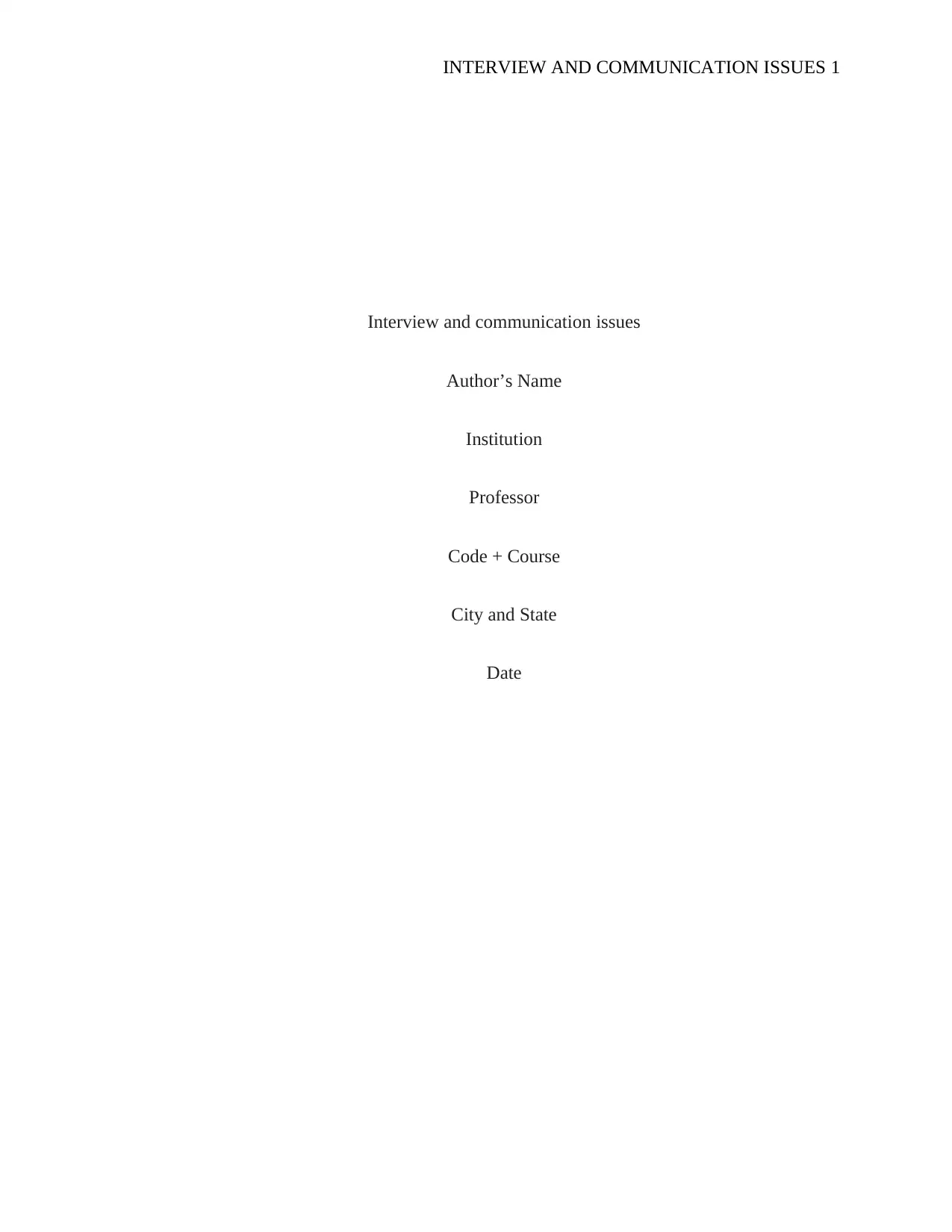
INTERVIEW AND COMMUNICATION ISSUES 1
Interview and communication issues
Author’s Name
Institution
Professor
Code + Course
City and State
Date
Interview and communication issues
Author’s Name
Institution
Professor
Code + Course
City and State
Date
Paraphrase This Document
Need a fresh take? Get an instant paraphrase of this document with our AI Paraphraser
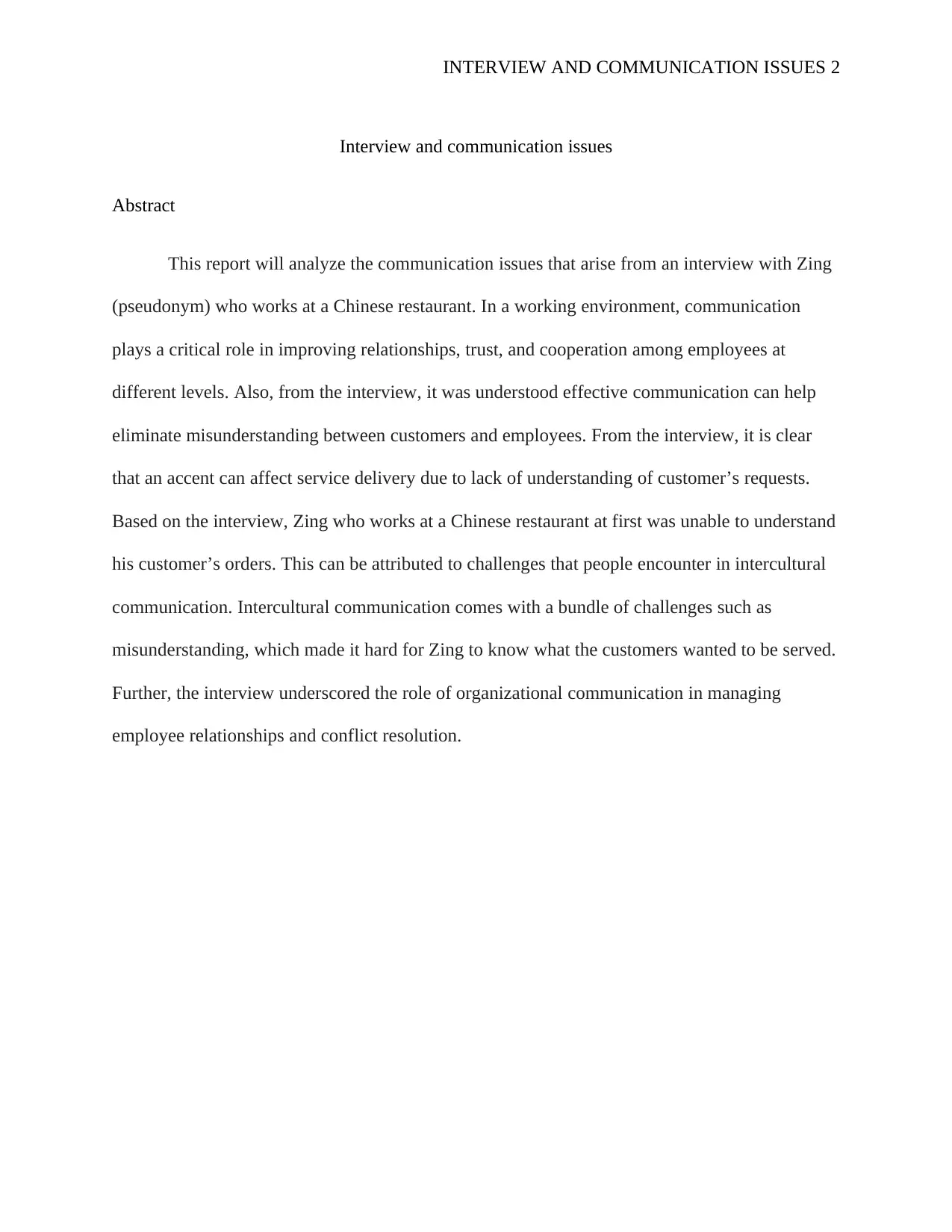
INTERVIEW AND COMMUNICATION ISSUES 2
Interview and communication issues
Abstract
This report will analyze the communication issues that arise from an interview with Zing
(pseudonym) who works at a Chinese restaurant. In a working environment, communication
plays a critical role in improving relationships, trust, and cooperation among employees at
different levels. Also, from the interview, it was understood effective communication can help
eliminate misunderstanding between customers and employees. From the interview, it is clear
that an accent can affect service delivery due to lack of understanding of customer’s requests.
Based on the interview, Zing who works at a Chinese restaurant at first was unable to understand
his customer’s orders. This can be attributed to challenges that people encounter in intercultural
communication. Intercultural communication comes with a bundle of challenges such as
misunderstanding, which made it hard for Zing to know what the customers wanted to be served.
Further, the interview underscored the role of organizational communication in managing
employee relationships and conflict resolution.
Interview and communication issues
Abstract
This report will analyze the communication issues that arise from an interview with Zing
(pseudonym) who works at a Chinese restaurant. In a working environment, communication
plays a critical role in improving relationships, trust, and cooperation among employees at
different levels. Also, from the interview, it was understood effective communication can help
eliminate misunderstanding between customers and employees. From the interview, it is clear
that an accent can affect service delivery due to lack of understanding of customer’s requests.
Based on the interview, Zing who works at a Chinese restaurant at first was unable to understand
his customer’s orders. This can be attributed to challenges that people encounter in intercultural
communication. Intercultural communication comes with a bundle of challenges such as
misunderstanding, which made it hard for Zing to know what the customers wanted to be served.
Further, the interview underscored the role of organizational communication in managing
employee relationships and conflict resolution.
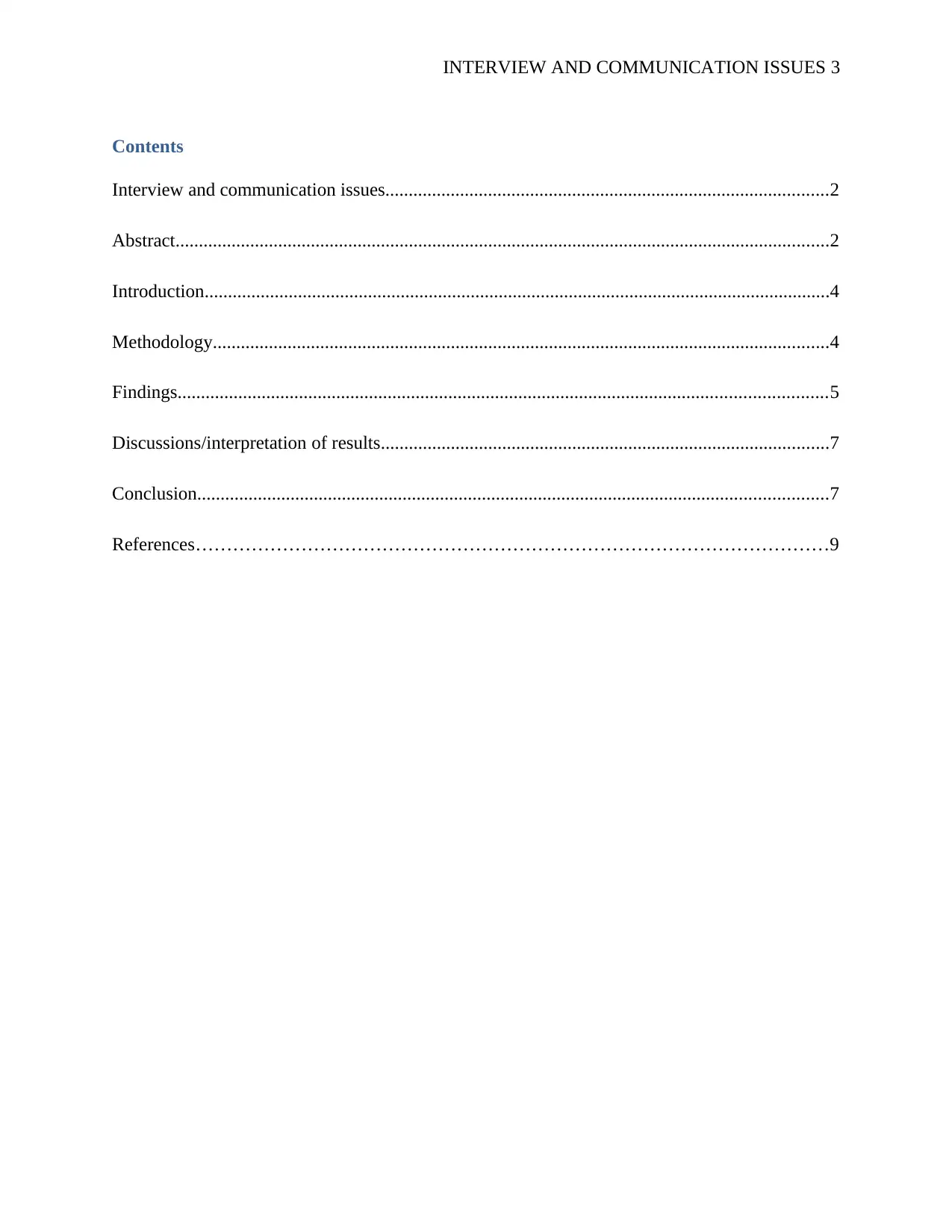
INTERVIEW AND COMMUNICATION ISSUES 3
Contents
Interview and communication issues...............................................................................................2
Abstract............................................................................................................................................2
Introduction......................................................................................................................................4
Methodology....................................................................................................................................4
Findings...........................................................................................................................................5
Discussions/interpretation of results................................................................................................7
Conclusion.......................................................................................................................................7
References…………………………………………………………………………………………9
Contents
Interview and communication issues...............................................................................................2
Abstract............................................................................................................................................2
Introduction......................................................................................................................................4
Methodology....................................................................................................................................4
Findings...........................................................................................................................................5
Discussions/interpretation of results................................................................................................7
Conclusion.......................................................................................................................................7
References…………………………………………………………………………………………9
⊘ This is a preview!⊘
Do you want full access?
Subscribe today to unlock all pages.

Trusted by 1+ million students worldwide
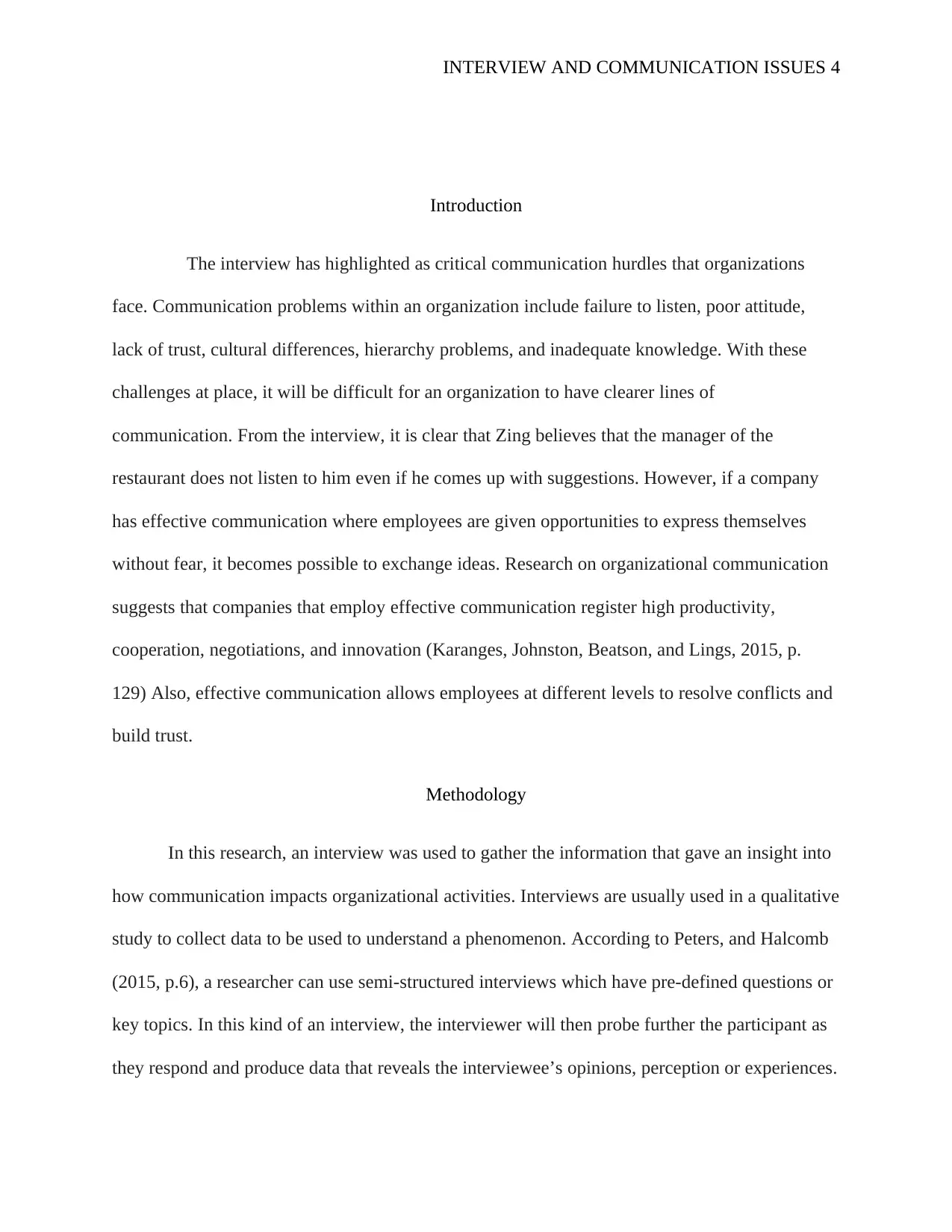
INTERVIEW AND COMMUNICATION ISSUES 4
Introduction
The interview has highlighted as critical communication hurdles that organizations
face. Communication problems within an organization include failure to listen, poor attitude,
lack of trust, cultural differences, hierarchy problems, and inadequate knowledge. With these
challenges at place, it will be difficult for an organization to have clearer lines of
communication. From the interview, it is clear that Zing believes that the manager of the
restaurant does not listen to him even if he comes up with suggestions. However, if a company
has effective communication where employees are given opportunities to express themselves
without fear, it becomes possible to exchange ideas. Research on organizational communication
suggests that companies that employ effective communication register high productivity,
cooperation, negotiations, and innovation (Karanges, Johnston, Beatson, and Lings, 2015, p.
129) Also, effective communication allows employees at different levels to resolve conflicts and
build trust.
Methodology
In this research, an interview was used to gather the information that gave an insight into
how communication impacts organizational activities. Interviews are usually used in a qualitative
study to collect data to be used to understand a phenomenon. According to Peters, and Halcomb
(2015, p.6), a researcher can use semi-structured interviews which have pre-defined questions or
key topics. In this kind of an interview, the interviewer will then probe further the participant as
they respond and produce data that reveals the interviewee’s opinions, perception or experiences.
Introduction
The interview has highlighted as critical communication hurdles that organizations
face. Communication problems within an organization include failure to listen, poor attitude,
lack of trust, cultural differences, hierarchy problems, and inadequate knowledge. With these
challenges at place, it will be difficult for an organization to have clearer lines of
communication. From the interview, it is clear that Zing believes that the manager of the
restaurant does not listen to him even if he comes up with suggestions. However, if a company
has effective communication where employees are given opportunities to express themselves
without fear, it becomes possible to exchange ideas. Research on organizational communication
suggests that companies that employ effective communication register high productivity,
cooperation, negotiations, and innovation (Karanges, Johnston, Beatson, and Lings, 2015, p.
129) Also, effective communication allows employees at different levels to resolve conflicts and
build trust.
Methodology
In this research, an interview was used to gather the information that gave an insight into
how communication impacts organizational activities. Interviews are usually used in a qualitative
study to collect data to be used to understand a phenomenon. According to Peters, and Halcomb
(2015, p.6), a researcher can use semi-structured interviews which have pre-defined questions or
key topics. In this kind of an interview, the interviewer will then probe further the participant as
they respond and produce data that reveals the interviewee’s opinions, perception or experiences.
Paraphrase This Document
Need a fresh take? Get an instant paraphrase of this document with our AI Paraphraser

INTERVIEW AND COMMUNICATION ISSUES 5
An interview was used in this research and the questions asked seemed to portray the interview
as semi-structured. From the audio, it is clear that the interviewer seemed to have pre-defined
questions.
The procedure that was used to conduct the recorded interview was simple. The
writing of Spradley (2016, p.4) about “The ethnographic interview” reveals that before an
interview is conducted there is need to prepare. In reference to the audio interview, it is apparent
that the researcher prepared for the interview and that is why the interview questions were clear.
Zing (pseudonym) was able to respond to all questions as he deemed because the interviewer line
of questioning was simple and clear. This shows efforts both the researcher and information
invested in the interview in order to succeed it. Ordinarily, once the researcher gets contacts with
the person to interview they prepare for it. Preparations will include agreeing on the venue for
the interview, its objective and time. With that in place, it becomes easy to conduct an interview
and the research will be able to collect important data. Essentially, this was a simple interview
that was not complicated and the interviewee was able to share information that he thought was
vital to the interviewer. Also, the informant was clear in his responses and this helped the
researcher to collect data with ease.
Findings
From the interview, it was found that the organization where the waiter, Zing works has
communication problems. First, the restaurant does not have proper negotiation procedures. Brett
and Thompson (2016, p.68) affirmed that negotiations are supposed to be carried out in an
environment where there is inclination to trust. In addition, an organization is supposed to have
structured negotiation and this only happens if an organization has effective organizational
An interview was used in this research and the questions asked seemed to portray the interview
as semi-structured. From the audio, it is clear that the interviewer seemed to have pre-defined
questions.
The procedure that was used to conduct the recorded interview was simple. The
writing of Spradley (2016, p.4) about “The ethnographic interview” reveals that before an
interview is conducted there is need to prepare. In reference to the audio interview, it is apparent
that the researcher prepared for the interview and that is why the interview questions were clear.
Zing (pseudonym) was able to respond to all questions as he deemed because the interviewer line
of questioning was simple and clear. This shows efforts both the researcher and information
invested in the interview in order to succeed it. Ordinarily, once the researcher gets contacts with
the person to interview they prepare for it. Preparations will include agreeing on the venue for
the interview, its objective and time. With that in place, it becomes easy to conduct an interview
and the research will be able to collect important data. Essentially, this was a simple interview
that was not complicated and the interviewee was able to share information that he thought was
vital to the interviewer. Also, the informant was clear in his responses and this helped the
researcher to collect data with ease.
Findings
From the interview, it was found that the organization where the waiter, Zing works has
communication problems. First, the restaurant does not have proper negotiation procedures. Brett
and Thompson (2016, p.68) affirmed that negotiations are supposed to be carried out in an
environment where there is inclination to trust. In addition, an organization is supposed to have
structured negotiation and this only happens if an organization has effective organizational
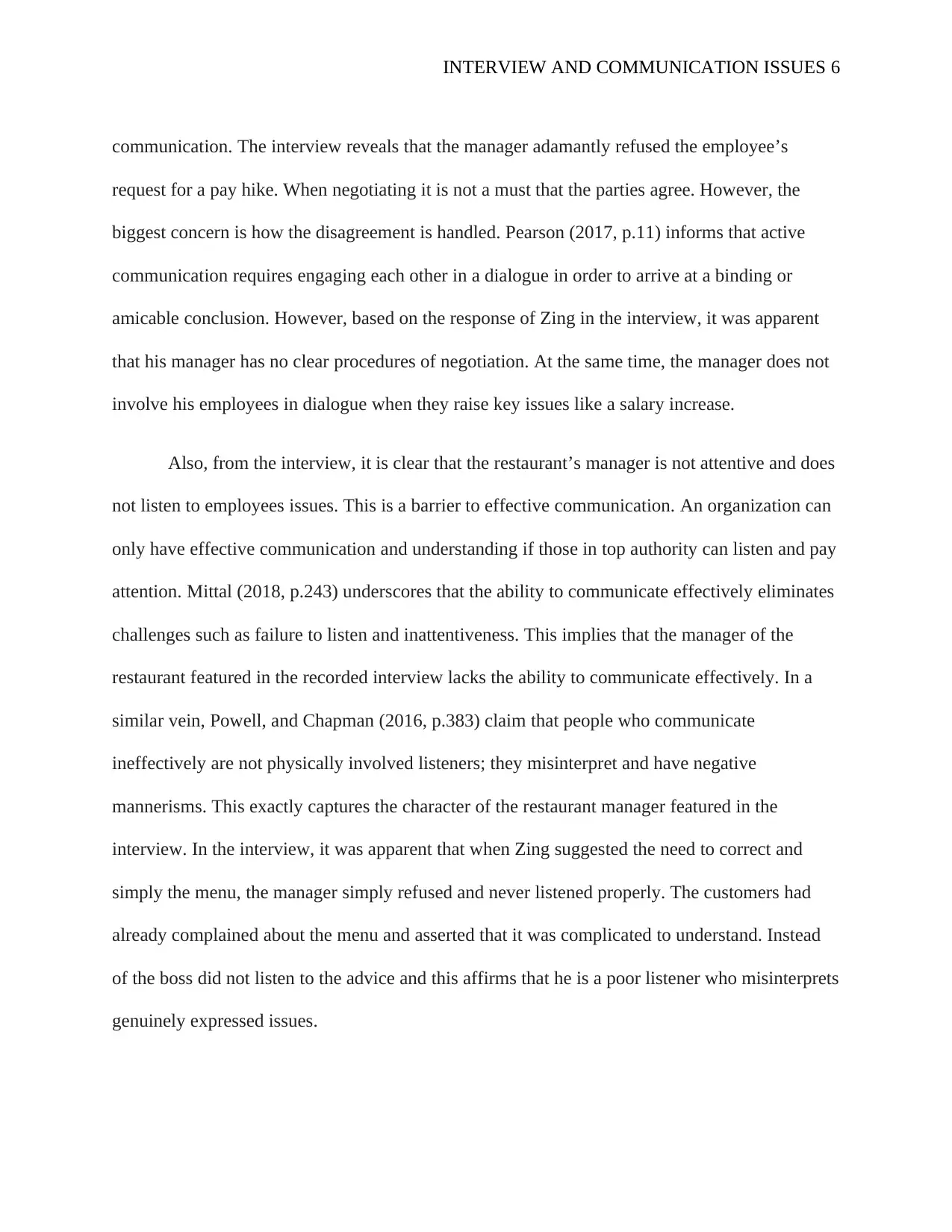
INTERVIEW AND COMMUNICATION ISSUES 6
communication. The interview reveals that the manager adamantly refused the employee’s
request for a pay hike. When negotiating it is not a must that the parties agree. However, the
biggest concern is how the disagreement is handled. Pearson (2017, p.11) informs that active
communication requires engaging each other in a dialogue in order to arrive at a binding or
amicable conclusion. However, based on the response of Zing in the interview, it was apparent
that his manager has no clear procedures of negotiation. At the same time, the manager does not
involve his employees in dialogue when they raise key issues like a salary increase.
Also, from the interview, it is clear that the restaurant’s manager is not attentive and does
not listen to employees issues. This is a barrier to effective communication. An organization can
only have effective communication and understanding if those in top authority can listen and pay
attention. Mittal (2018, p.243) underscores that the ability to communicate effectively eliminates
challenges such as failure to listen and inattentiveness. This implies that the manager of the
restaurant featured in the recorded interview lacks the ability to communicate effectively. In a
similar vein, Powell, and Chapman (2016, p.383) claim that people who communicate
ineffectively are not physically involved listeners; they misinterpret and have negative
mannerisms. This exactly captures the character of the restaurant manager featured in the
interview. In the interview, it was apparent that when Zing suggested the need to correct and
simply the menu, the manager simply refused and never listened properly. The customers had
already complained about the menu and asserted that it was complicated to understand. Instead
of the boss did not listen to the advice and this affirms that he is a poor listener who misinterprets
genuinely expressed issues.
communication. The interview reveals that the manager adamantly refused the employee’s
request for a pay hike. When negotiating it is not a must that the parties agree. However, the
biggest concern is how the disagreement is handled. Pearson (2017, p.11) informs that active
communication requires engaging each other in a dialogue in order to arrive at a binding or
amicable conclusion. However, based on the response of Zing in the interview, it was apparent
that his manager has no clear procedures of negotiation. At the same time, the manager does not
involve his employees in dialogue when they raise key issues like a salary increase.
Also, from the interview, it is clear that the restaurant’s manager is not attentive and does
not listen to employees issues. This is a barrier to effective communication. An organization can
only have effective communication and understanding if those in top authority can listen and pay
attention. Mittal (2018, p.243) underscores that the ability to communicate effectively eliminates
challenges such as failure to listen and inattentiveness. This implies that the manager of the
restaurant featured in the recorded interview lacks the ability to communicate effectively. In a
similar vein, Powell, and Chapman (2016, p.383) claim that people who communicate
ineffectively are not physically involved listeners; they misinterpret and have negative
mannerisms. This exactly captures the character of the restaurant manager featured in the
interview. In the interview, it was apparent that when Zing suggested the need to correct and
simply the menu, the manager simply refused and never listened properly. The customers had
already complained about the menu and asserted that it was complicated to understand. Instead
of the boss did not listen to the advice and this affirms that he is a poor listener who misinterprets
genuinely expressed issues.
⊘ This is a preview!⊘
Do you want full access?
Subscribe today to unlock all pages.

Trusted by 1+ million students worldwide
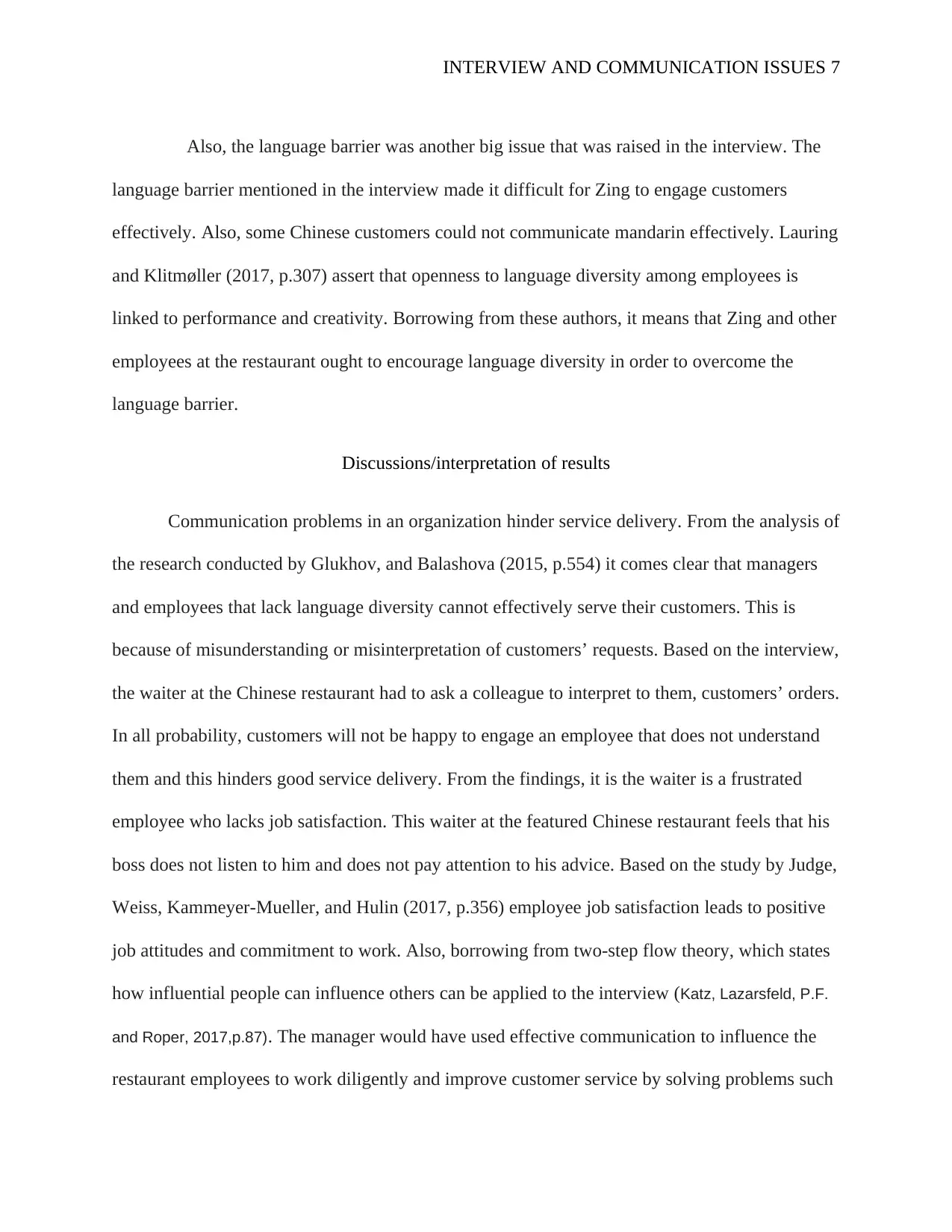
INTERVIEW AND COMMUNICATION ISSUES 7
Also, the language barrier was another big issue that was raised in the interview. The
language barrier mentioned in the interview made it difficult for Zing to engage customers
effectively. Also, some Chinese customers could not communicate mandarin effectively. Lauring
and Klitmøller (2017, p.307) assert that openness to language diversity among employees is
linked to performance and creativity. Borrowing from these authors, it means that Zing and other
employees at the restaurant ought to encourage language diversity in order to overcome the
language barrier.
Discussions/interpretation of results
Communication problems in an organization hinder service delivery. From the analysis of
the research conducted by Glukhov, and Balashova (2015, p.554) it comes clear that managers
and employees that lack language diversity cannot effectively serve their customers. This is
because of misunderstanding or misinterpretation of customers’ requests. Based on the interview,
the waiter at the Chinese restaurant had to ask a colleague to interpret to them, customers’ orders.
In all probability, customers will not be happy to engage an employee that does not understand
them and this hinders good service delivery. From the findings, it is the waiter is a frustrated
employee who lacks job satisfaction. This waiter at the featured Chinese restaurant feels that his
boss does not listen to him and does not pay attention to his advice. Based on the study by Judge,
Weiss, Kammeyer-Mueller, and Hulin (2017, p.356) employee job satisfaction leads to positive
job attitudes and commitment to work. Also, borrowing from two-step flow theory, which states
how influential people can influence others can be applied to the interview (Katz, Lazarsfeld, P.F.
and Roper, 2017,p.87). The manager would have used effective communication to influence the
restaurant employees to work diligently and improve customer service by solving problems such
Also, the language barrier was another big issue that was raised in the interview. The
language barrier mentioned in the interview made it difficult for Zing to engage customers
effectively. Also, some Chinese customers could not communicate mandarin effectively. Lauring
and Klitmøller (2017, p.307) assert that openness to language diversity among employees is
linked to performance and creativity. Borrowing from these authors, it means that Zing and other
employees at the restaurant ought to encourage language diversity in order to overcome the
language barrier.
Discussions/interpretation of results
Communication problems in an organization hinder service delivery. From the analysis of
the research conducted by Glukhov, and Balashova (2015, p.554) it comes clear that managers
and employees that lack language diversity cannot effectively serve their customers. This is
because of misunderstanding or misinterpretation of customers’ requests. Based on the interview,
the waiter at the Chinese restaurant had to ask a colleague to interpret to them, customers’ orders.
In all probability, customers will not be happy to engage an employee that does not understand
them and this hinders good service delivery. From the findings, it is the waiter is a frustrated
employee who lacks job satisfaction. This waiter at the featured Chinese restaurant feels that his
boss does not listen to him and does not pay attention to his advice. Based on the study by Judge,
Weiss, Kammeyer-Mueller, and Hulin (2017, p.356) employee job satisfaction leads to positive
job attitudes and commitment to work. Also, borrowing from two-step flow theory, which states
how influential people can influence others can be applied to the interview (Katz, Lazarsfeld, P.F.
and Roper, 2017,p.87). The manager would have used effective communication to influence the
restaurant employees to work diligently and improve customer service by solving problems such
Paraphrase This Document
Need a fresh take? Get an instant paraphrase of this document with our AI Paraphraser
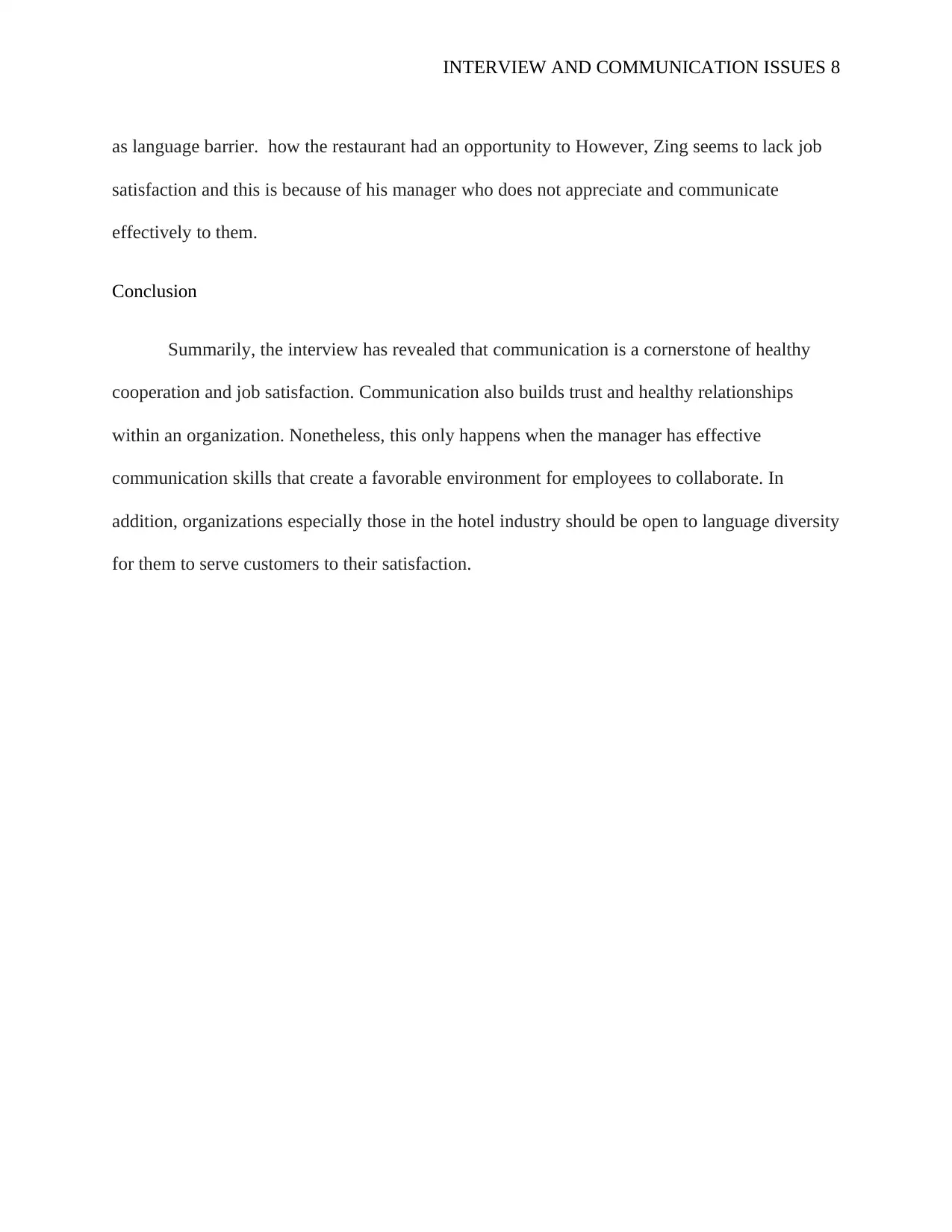
INTERVIEW AND COMMUNICATION ISSUES 8
as language barrier. how the restaurant had an opportunity to However, Zing seems to lack job
satisfaction and this is because of his manager who does not appreciate and communicate
effectively to them.
Conclusion
Summarily, the interview has revealed that communication is a cornerstone of healthy
cooperation and job satisfaction. Communication also builds trust and healthy relationships
within an organization. Nonetheless, this only happens when the manager has effective
communication skills that create a favorable environment for employees to collaborate. In
addition, organizations especially those in the hotel industry should be open to language diversity
for them to serve customers to their satisfaction.
as language barrier. how the restaurant had an opportunity to However, Zing seems to lack job
satisfaction and this is because of his manager who does not appreciate and communicate
effectively to them.
Conclusion
Summarily, the interview has revealed that communication is a cornerstone of healthy
cooperation and job satisfaction. Communication also builds trust and healthy relationships
within an organization. Nonetheless, this only happens when the manager has effective
communication skills that create a favorable environment for employees to collaborate. In
addition, organizations especially those in the hotel industry should be open to language diversity
for them to serve customers to their satisfaction.
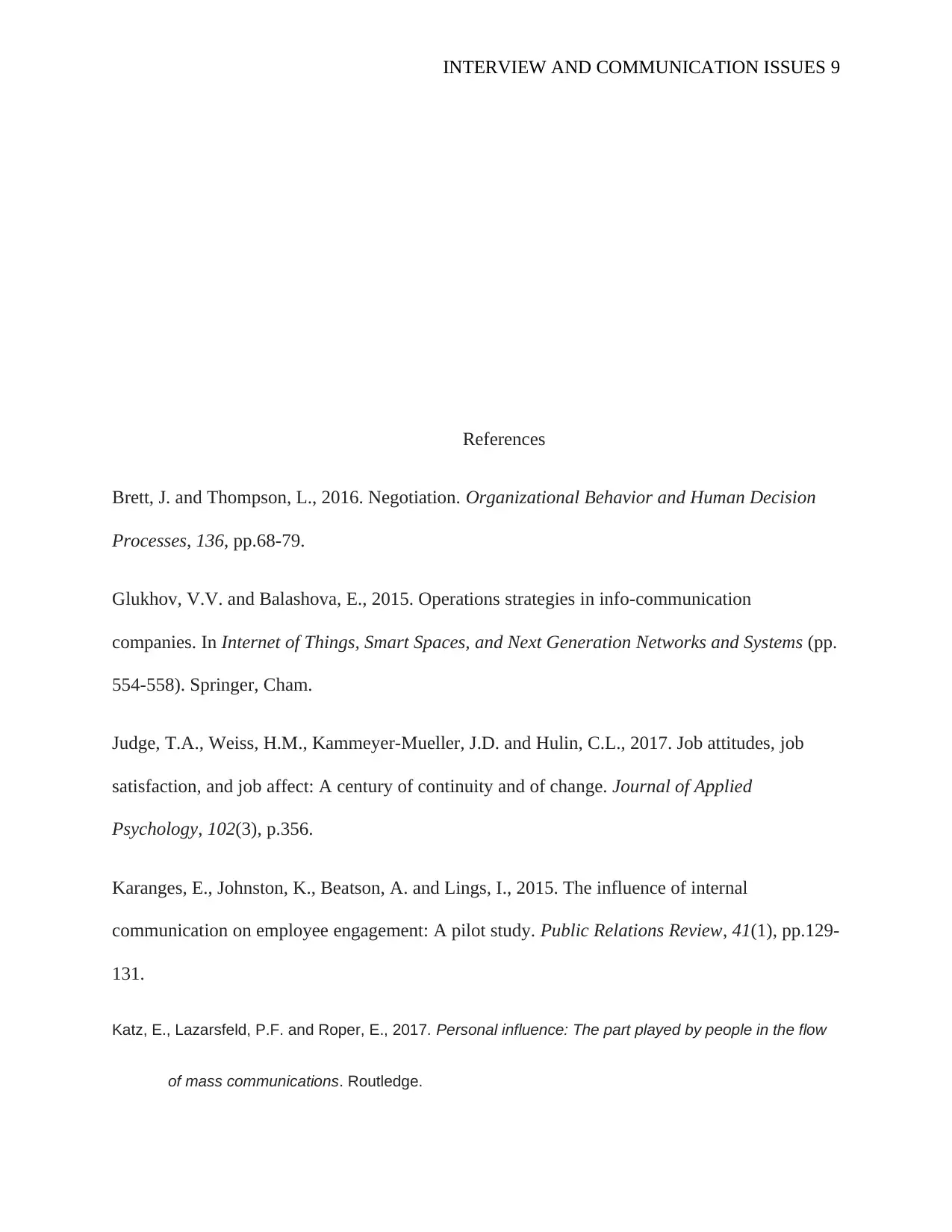
INTERVIEW AND COMMUNICATION ISSUES 9
References
Brett, J. and Thompson, L., 2016. Negotiation. Organizational Behavior and Human Decision
Processes, 136, pp.68-79.
Glukhov, V.V. and Balashova, E., 2015. Operations strategies in info-communication
companies. In Internet of Things, Smart Spaces, and Next Generation Networks and Systems (pp.
554-558). Springer, Cham.
Judge, T.A., Weiss, H.M., Kammeyer-Mueller, J.D. and Hulin, C.L., 2017. Job attitudes, job
satisfaction, and job affect: A century of continuity and of change. Journal of Applied
Psychology, 102(3), p.356.
Karanges, E., Johnston, K., Beatson, A. and Lings, I., 2015. The influence of internal
communication on employee engagement: A pilot study. Public Relations Review, 41(1), pp.129-
131.
Katz, E., Lazarsfeld, P.F. and Roper, E., 2017. Personal influence: The part played by people in the flow
of mass communications. Routledge.
References
Brett, J. and Thompson, L., 2016. Negotiation. Organizational Behavior and Human Decision
Processes, 136, pp.68-79.
Glukhov, V.V. and Balashova, E., 2015. Operations strategies in info-communication
companies. In Internet of Things, Smart Spaces, and Next Generation Networks and Systems (pp.
554-558). Springer, Cham.
Judge, T.A., Weiss, H.M., Kammeyer-Mueller, J.D. and Hulin, C.L., 2017. Job attitudes, job
satisfaction, and job affect: A century of continuity and of change. Journal of Applied
Psychology, 102(3), p.356.
Karanges, E., Johnston, K., Beatson, A. and Lings, I., 2015. The influence of internal
communication on employee engagement: A pilot study. Public Relations Review, 41(1), pp.129-
131.
Katz, E., Lazarsfeld, P.F. and Roper, E., 2017. Personal influence: The part played by people in the flow
of mass communications. Routledge.
⊘ This is a preview!⊘
Do you want full access?
Subscribe today to unlock all pages.

Trusted by 1+ million students worldwide
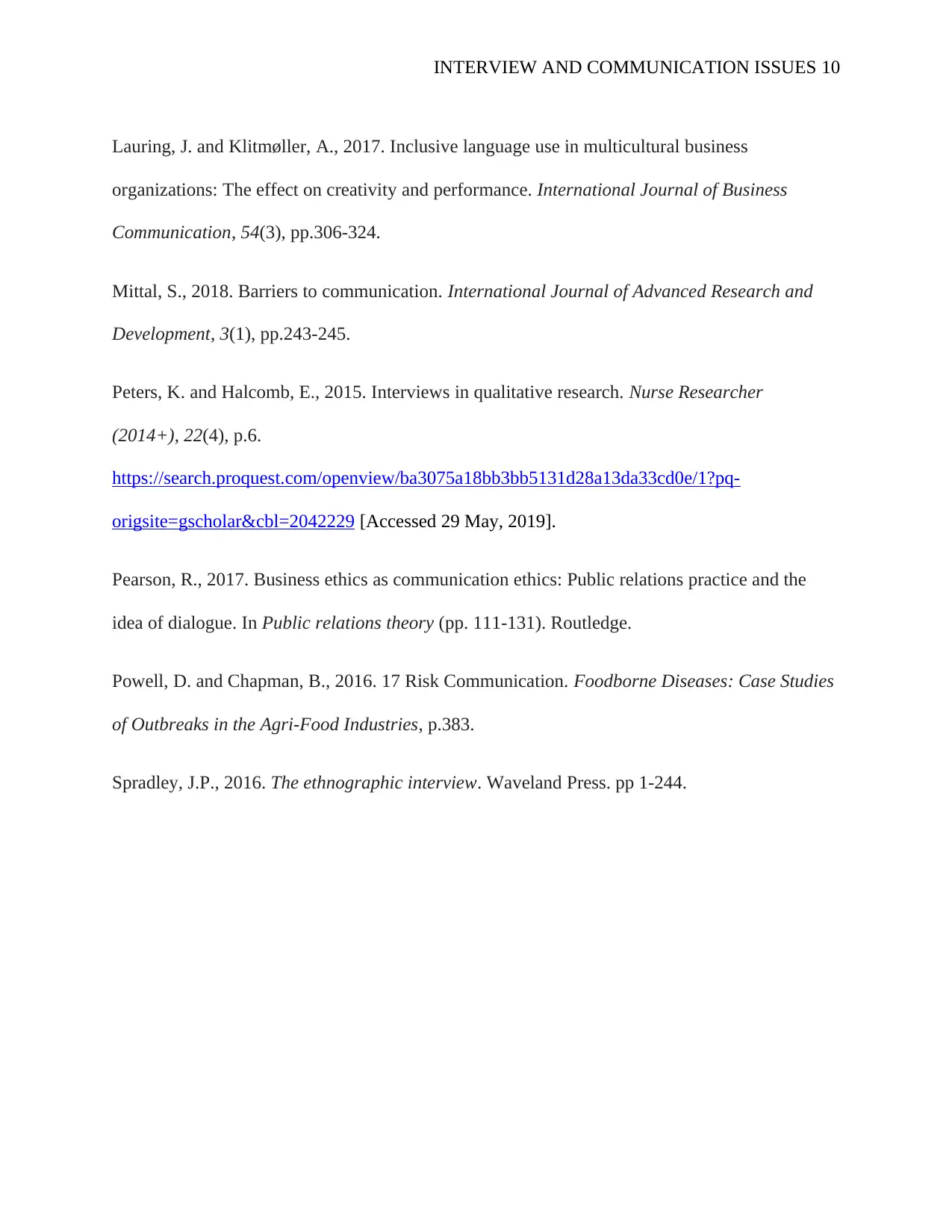
INTERVIEW AND COMMUNICATION ISSUES 10
Lauring, J. and Klitmøller, A., 2017. Inclusive language use in multicultural business
organizations: The effect on creativity and performance. International Journal of Business
Communication, 54(3), pp.306-324.
Mittal, S., 2018. Barriers to communication. International Journal of Advanced Research and
Development, 3(1), pp.243-245.
Peters, K. and Halcomb, E., 2015. Interviews in qualitative research. Nurse Researcher
(2014+), 22(4), p.6.
https://search.proquest.com/openview/ba3075a18bb3bb5131d28a13da33cd0e/1?pq-
origsite=gscholar&cbl=2042229 [Accessed 29 May, 2019].
Pearson, R., 2017. Business ethics as communication ethics: Public relations practice and the
idea of dialogue. In Public relations theory (pp. 111-131). Routledge.
Powell, D. and Chapman, B., 2016. 17 Risk Communication. Foodborne Diseases: Case Studies
of Outbreaks in the Agri-Food Industries, p.383.
Spradley, J.P., 2016. The ethnographic interview. Waveland Press. pp 1-244.
Lauring, J. and Klitmøller, A., 2017. Inclusive language use in multicultural business
organizations: The effect on creativity and performance. International Journal of Business
Communication, 54(3), pp.306-324.
Mittal, S., 2018. Barriers to communication. International Journal of Advanced Research and
Development, 3(1), pp.243-245.
Peters, K. and Halcomb, E., 2015. Interviews in qualitative research. Nurse Researcher
(2014+), 22(4), p.6.
https://search.proquest.com/openview/ba3075a18bb3bb5131d28a13da33cd0e/1?pq-
origsite=gscholar&cbl=2042229 [Accessed 29 May, 2019].
Pearson, R., 2017. Business ethics as communication ethics: Public relations practice and the
idea of dialogue. In Public relations theory (pp. 111-131). Routledge.
Powell, D. and Chapman, B., 2016. 17 Risk Communication. Foodborne Diseases: Case Studies
of Outbreaks in the Agri-Food Industries, p.383.
Spradley, J.P., 2016. The ethnographic interview. Waveland Press. pp 1-244.
1 out of 10
Related Documents
Your All-in-One AI-Powered Toolkit for Academic Success.
+13062052269
info@desklib.com
Available 24*7 on WhatsApp / Email
![[object Object]](/_next/static/media/star-bottom.7253800d.svg)
Unlock your academic potential
Copyright © 2020–2025 A2Z Services. All Rights Reserved. Developed and managed by ZUCOL.





